Featured Project: Kaiser Vallejo Courtyards
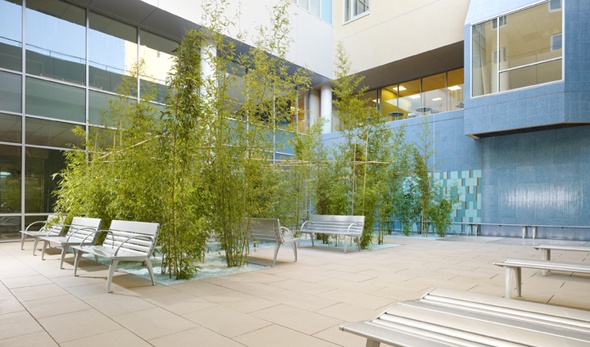
Entry Court Seating (Photo Credits: Cesar Rubio)
We’re pleased to share the latest images of a recently completed project: the courtyards at Kaiser Vallejo. We were tasked with designing the entry, dining, and rehabilitation courtyard spaces, maintaining a similar design language between the three while creating unique experiences for each. We elected to achieve this via bamboo plantings, using the natural architectural characteristics of the bamboo’s form to create a visual continuity between outside and inside on each floor, while relating each of the courts to each other. Make sure to check out more images of this project on our website.
Featured Project: Noel Barnhurst Studios
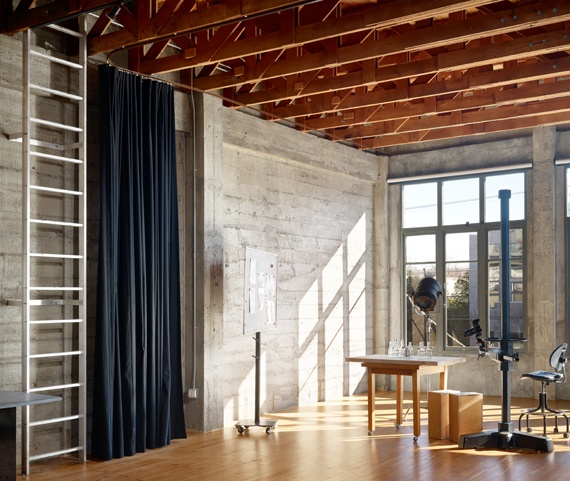
photo credit: Cesar Rubio
We’re happy to share some finished photography of our most recently completed project: the studios of Noel Barnhurst. We were asked to renovate a 1930’s era concrete warehouse located in San Francisco’s SOMA district to accommodate the client’s food photography studio as well as other associated program including test + preparation kitchens, as well as office + conference spaces. We appreciated the raw material character of the existing building and worked to preserve these elements while making sure new construction complemented the building’s existing material palette. Hand in hand with this strategy, we avoided creating hard partitions and opted instead for a series of heavy velour curtains to divide space — ensuring the spatial organization remained open-ended and keeping the physical presence of the building in focus.
You can see more images of the project on our website.
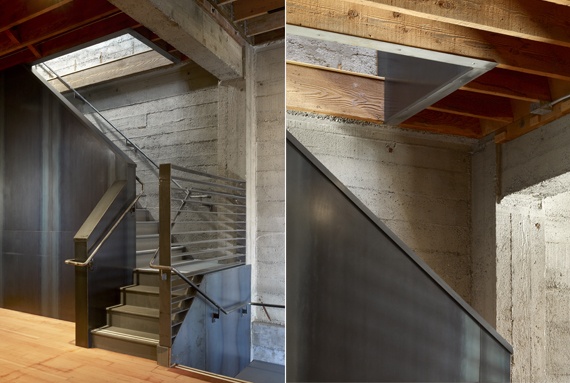
photo credit: Cesar Rubio
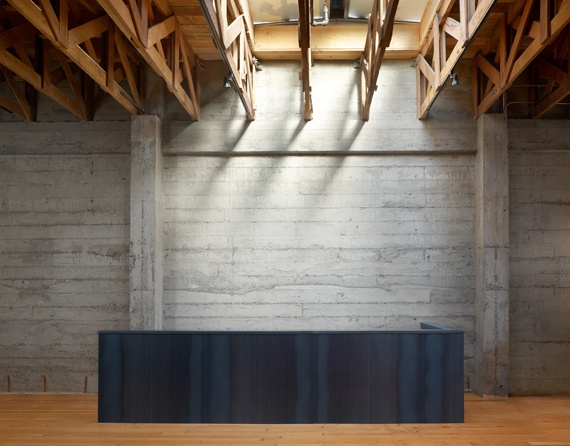
photo credit: Cesar Rubio
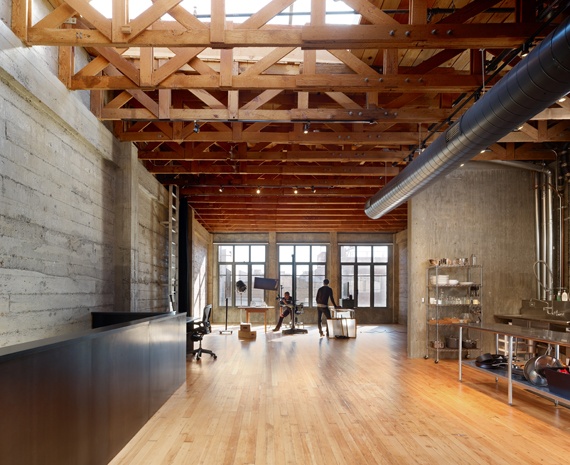
photo credit: Cesar Rubio
Agristructure | Ecostructure Featured in arcCA
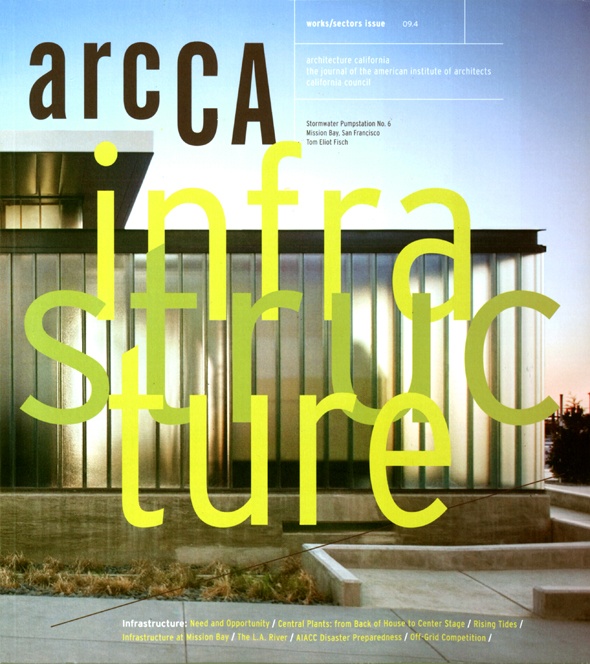
We are pleased to have our submission to the 2009 Off Grid 2.0 competition featured in the Works/Sectors Issue ( issue 09.4) of arcCA! Our project, titled “Agristricture | Ecostructure,” was awarded the Special Jury Commendation which in the words of the jury, “Was a very ambitious entry that explored teaching opportunities to a high degree … This solution is highly engaged in activities that support environmental learning.” The competition brief called for creative solutions to the remediation and redesign of Horseshoe Cove, a small ecological infill site that was once a marshland, drained and reclaimed by the military in the 1800s.

View of the New Horseshoe Cove from Kayak Launch
This project creates a high visibility public infrastructure that addresses the dynamic condition of the greater San Francisco Bay area ecosystem while creating a framework through which users may experience the ever changing local conditions of the site.
Given the increasingly complex shifts being brought upon Bay Area ecologies by global climate change, we believe that landscape itself can be a type of generative “soft” infrastructure, not only capable of fostering local remediation, but acting as an synthetically maintained ecological system which “seeds” other at risk ecological infill sites – re-establishing processes halted by years of development and environmental disruption.
Inspired by the research of Dr. Katharyn Boyer, the project’s two major functions are the replenishment of native eelgrass, and the production of critical natural resources to be used in a larger Bay-Wide remediation scheme.
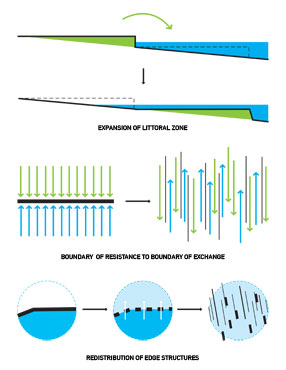
Site Strategy
This solution is initiated by first re-distributing the sea wall boundary, and transforming the site into a blurred tidal edge. We employ a series of simple performance typologies to create a sustaining landscape, and water/land ecologies evolve as we re-appropriate agricultural systems to create self-generating ecological structures. In shifting the context of these processes, we will also engender a transition from a culture of consumption to a culture of stewardship.
The site is organized and “grown” through the implementation of both Eco-structures and Agri-structures which create a highly concentrated wetland ecotone. These structures include redistributed land form, low-impact access catwalks, and distribution networks – together generating a site-wide “Plot” nursery for desperately needed habitats and endangered native species. The Plots are the biomass products of emergent wetland ecologies. The surplus production of the Plots is exported to other sites as they become available due to rising sea levels.
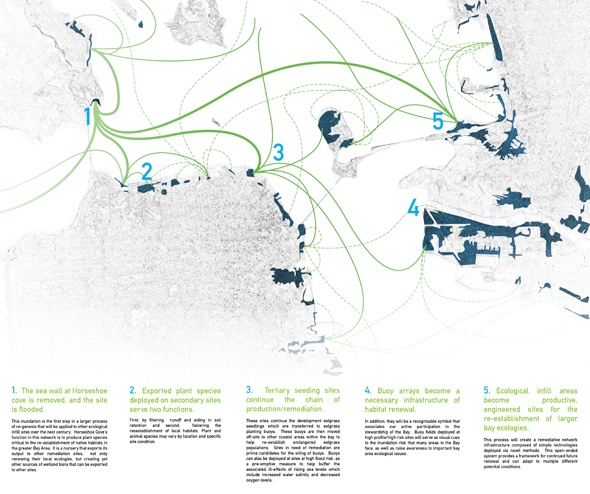
The "Remediative Network" - Mapping Potential Site Seeding
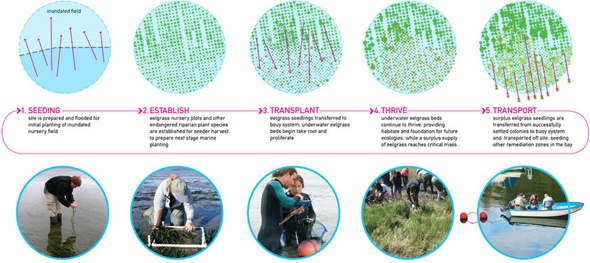
Eelgrass Cycle - Local Remediation Becomes Biomass Export
The simple flexible armatures, in turn, create program opportunities within the Plot nursery. The initial infrastructure recedes over time as proactive ecologies succeed. The Agri-structures remain, and are slowly reclaimed by the rising sea, eventually establishing a thriving marine estuary to become a destination for scientists, eco-tourists, and local residents alike. Our proposal is designed to remain perpetually unfinished, cultivating and capitalizing on emergent growth and flux, as the first node in an engineered remediation network of ecological and agricultural infill sites bay-wide.
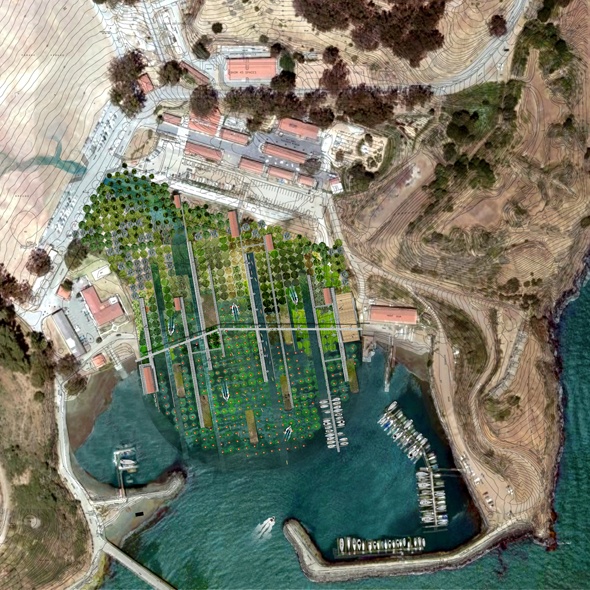
Plan - Ecological Infill or Productive Nursery?

Sections Through the Expanded Littoral Zone
Our design research for this project raised some topological questions regarding the role agriculture could play in ecological remediation, what the crossroads of infrastructure and natural systems might be like, the role of education in environmental design, and the true scales of impact local interventions could spark. These are by no means new questions, but given the current ecological and economic climate, we believe there is (or should be) a growing imperative towards open-ended, globally aware, locally sited design solutions. We want to rethink the idea of “public works” as a typically large, disruptive, and costly endeavor now replaced by smaller scale “soft” networks created through the exchange between a variety of fields, including architecture, landscape, environmental design, civil engineering, urban planning, logistics, social advocacy, and community leadership.
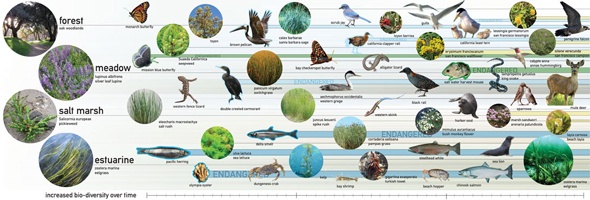
Ecological Web - Diversity Over Time
As we continue our research, we will document its progress on our blog – hoping to augment our findings through discussion and participation. We hope you enjoy putting forward whatever thoughtful insights, comments, criticisms, or resources you might have.
